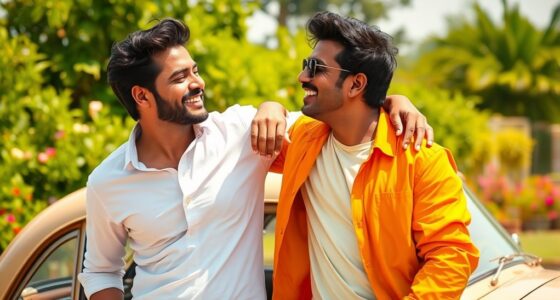Discover unforgettable Bollywood acting masterpieces that leave a lasting impact. From Rajesh Khanna’s heartfelt charm in Anand to Rekha’s subtle emotional depth in Umrao Jaan, each performance captures raw authenticity and nuance. Shreyas Talpade’s silent strength and Aamir Khan’s realistic portrayal in Sarfarash showcase the power of subtlety. Exploring these iconic roles reveals the true artistry behind emotionally resonant cinema. Keep going to uncover more about these legendary performances and their cinematic significance.
Key Takeaways
- Iconic performances like Rajesh Khanna’s Anand and Rekha’s Umrao Jaan showcase emotional depth, charm, and nuanced acting mastery.
- Authentic portrayals, such as Aamir Khan’s realistic cop in Sarfarosh and Shreyas Talpade’s silent resilience, set benchmarks in natural acting.
- Emotional range is demonstrated through layered expressions, subtle gestures, and voice modulation, creating unforgettable cinematic moments.
- Non-verbal communication and micro-expressions enhance performances, exemplified by actors like Talpade and Khanna, elevating storytelling.
- Cultural authenticity and critical acclaim highlight performances that resonate deeply, making them timeless masterpieces in Bollywood history.
Rajesh Khanna’s Iconic Portrayal in Anand
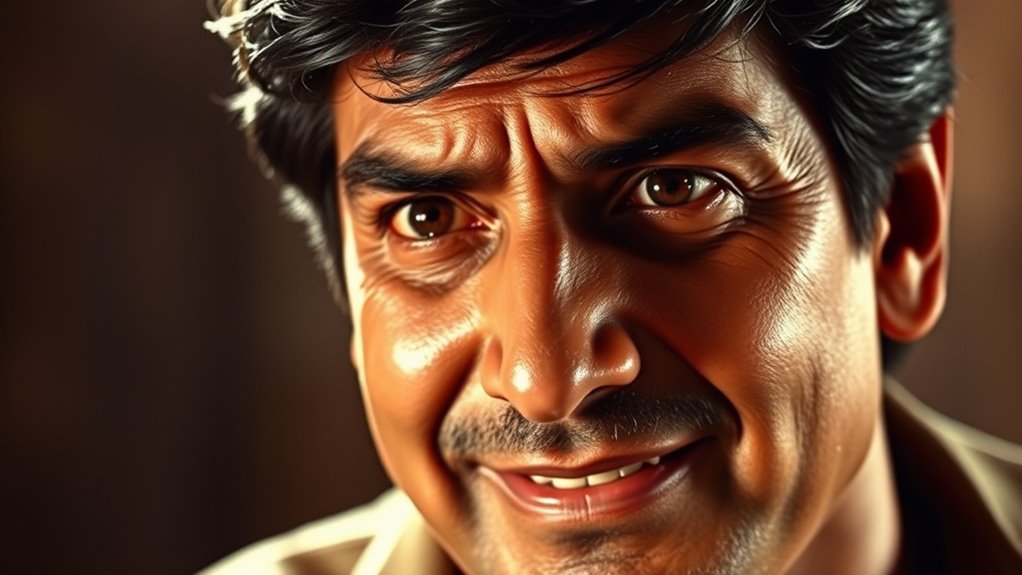
Rajesh Khanna’s portrayal of Anand in the 1971 film is widely regarded as one of his most memorable performances, capturing the character’s warmth, charisma, and emotional depth. You feel his infectious energy and genuine kindness through every scene, making Anand’s optimistic outlook inspiring. You sense his character’s zest for life and ability to uplift others, which defines the film’s emotional core. You can also see how Khanna’s natural acting talent enhances his ability to connect with the audience on a deeper level. Khanna skillfully balances his natural flair with subtle vulnerability, avoiding overacting despite his signature expressive style. His performance radiates charm and compassion, drawing you into Anand’s world of hope despite life’s hardships. His nuanced acting elevates the story, ensuring Anand’s legacy as a cinematic icon. Khanna’s performance remains etched in Indian cinema history for its sincerity and heartfelt appeal. Rajesh Khanna’s portrayal exemplifies the power of authentic acting, making the character of Anand both memorable and inspiring to audiences across generations. His ability to embody emotional authenticity contributes significantly to the film’s enduring impact.
Rekha’s Deep Emotional Expression in Umrao Jaan
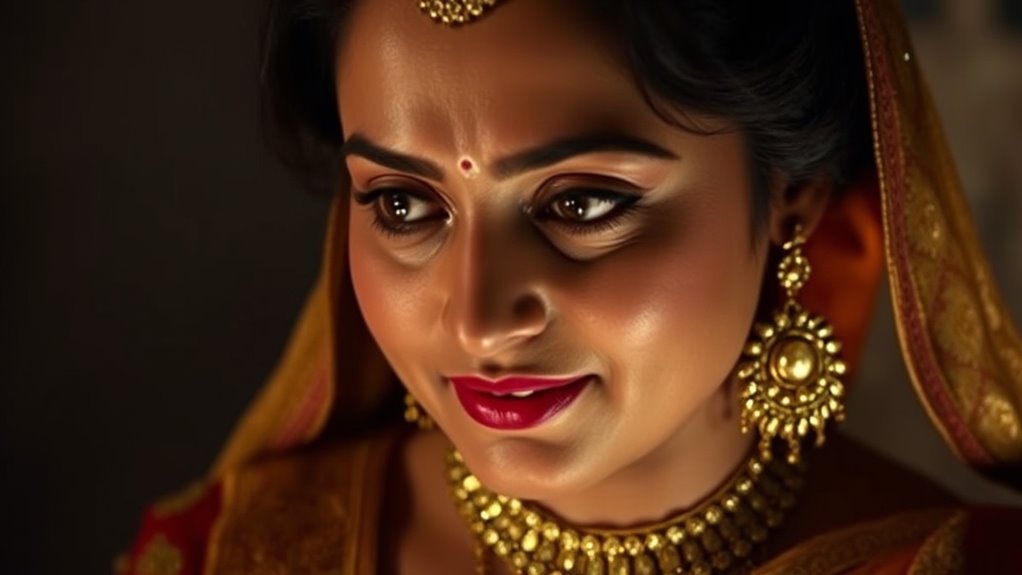
Rekha’s portrayal of Umrao Jaan stands out as one of the most emotionally profound performances in Bollywood history. You feel her subtlety and depth, as she masterfully conveys the inner turmoil behind Umrao’s glamorous exterior. Her calm, still presence creates a mysterious aura, inviting you into her character’s inner world. Rekha’s ability to express complex emotions with minimal action—through nuanced expressions and measured pauses—captures the essence of her character’s pain, longing, and resilience. Her performance balances sensuality with emotional distance, subtly revealing the social struggles and personal heartbreak Umrao endures. It’s this delicate artistry that elevates her role beyond mere acting, making her portrayal a poignant exploration of vulnerability, strength, and societal constraints. Her nuanced performance also reflects her understanding of the societal standards that shape gendered behaviors and expectations, adding layers of depth to her depiction. Additionally, her emotional expression demonstrates her mastery in conveying profound feelings without overt gestures, highlighting her deep connection to her character’s internal journey. Such a subtle yet powerful delivery is often supported by techniques like controlled facial expressions, which are crucial in conveying complex emotions without relying on overt gestures. This mastery aligns with the broader visionary qualities of great performers who elevate their craft through emotional intelligence and nuanced storytelling. Moreover, her ability to seamlessly blend internal emotional states with external gestures exemplifies her skill in portraying layered characters with authenticity. Recognizing the importance of dream analysis, her performance also embodies the idea that understanding one’s inner emotional landscape can lead to truly authentic portrayals.
Rani Mukerji’s Intensity in Black
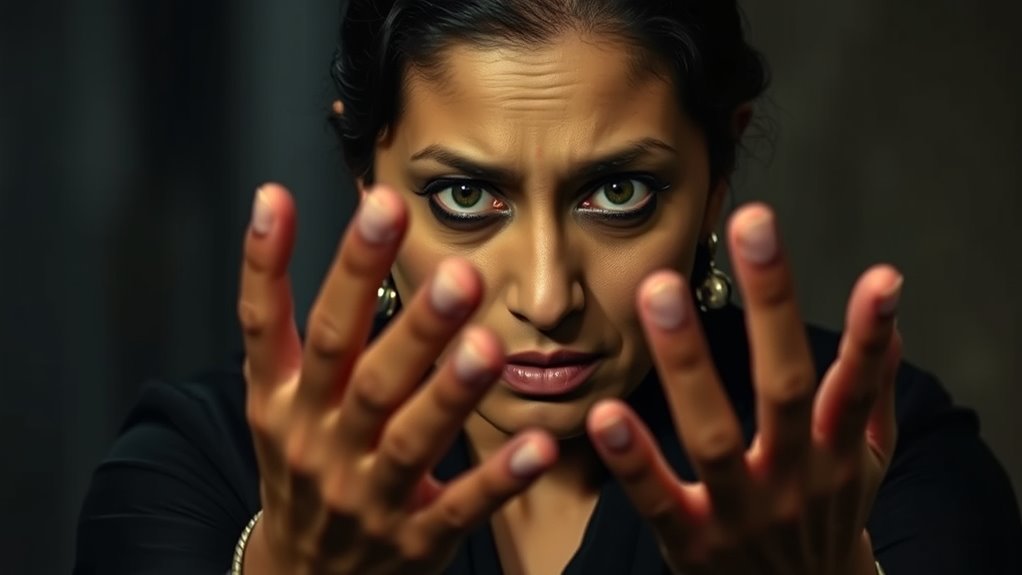
Rani Mukerji’s portrayal of Michelle McNally in *Black* is a masterclass in emotional intensity that leaves a lasting impact. You’ll notice her dedication as she trained in sign language and worked closely with children who are deaf and mute, immersing herself fully into the character’s world. Her performance was largely spontaneous, with minimal rehearsals and rare retakes, demonstrating her confidence and commitment. Mukerji’s ability to convey resilience and determination amid sensory disabilities pushes her acting to new heights, making her role both demanding and unforgettable. This transformative experience elevated her career, earning critical acclaim and showcasing her capacity for complex, challenging characters. Her authentic portrayal in *Black* remains a powerful testament to her immense talent and emotional depth. Maximum retakes for any scene was three, indicating her smooth and confident shooting process. Additionally, her methodical preparation played a crucial role in delivering such a nuanced performance, highlighting the importance of dedicated practice in achieving exceptional acting results.
Shreyas Talpade’s Silent Brilliance in Iqbal

You can see how Shreyas Talpade masterfully expresses a wide range of emotions without words, relying on subtle facial cues and body language. His performance shows that physical challenges like deafness and muteness can deepen a character’s portrayal, making their internal struggles more palpable. Talpade’s silent acting proves that genuine emotion doesn’t need dialogue to resonate powerfully. His portrayal demonstrates the power of non-verbal communication in conveying hope, determination, and resilience, inspiring audiences through his authentic performance. Additionally, his ability to maintain positive energy highlights the importance of mindset in delivering a compelling performance. The use of performance cookies can also enhance the understanding of how such performances impact viewer engagement and emotional response. Recognizing the significance of emotional expression emphasizes how subtle cues can effectively communicate complex feelings. Moreover, understanding the emotional impact of non-verbal cues can deepen appreciation for performances that rely heavily on physicality. Incorporating visual cues can further underscore how body language enriches storytelling and emotional depth.
Expressing Emotions Non-Verbally
Shreyas Talpade’s portrayal of Iqbal in the 2005 film *Iqbal* showcases a remarkable mastery of expressing complex emotions without uttering a single word. You can see how he uses subtle facial expressions and body language to convey hope, frustration, determination, and vulnerability. His quiet gestures reveal his character’s inner struggles and aspirations, making his emotional journey palpable. Without dialogue, Talpade relies on nuanced movements and eye contact, allowing you to connect deeply with Iqbal’s passion and resilience. The director’s guidance helps amplify these non-verbal cues, creating a natural and authentic performance. This skillful use of silent acting not only elevates the character but also immerses you in the story’s emotional depth, proving that words aren’t always necessary to tell a powerful story. It’s a testament to his talent that his ability to evoke such profound emotions through silence demonstrates the power of non-verbal communication in acting.
Impact of Physical Challenge
Shreyas Talpade’s portrayal of Iqbal isn’t just an emotional performance; it’s a profound display of acting under physical constraints. You’ll notice how he masterfully uses body language, facial expressions, and subtle gestures to communicate Iqbal’s inner world, compensating for his inability to speak or hear. This physical challenge elevates the role beyond a mere disability, highlighting perseverance and social barriers without stereotypes. Talpade’s controlled movements and micro-expressions create a convincing, authentic portrayal that resonates deeply with audiences and critics alike. His performance demands intense discipline, rehearsal, and focus, demonstrating how physical limitations can become a powerful storytelling device. Additionally, the use of eye patches in some scenes subtly emphasizes the character’s vulnerability and resilience, adding depth to his portrayal. This role also exemplifies how disability representation in cinema can foster greater empathy and understanding among viewers. Furthermore, Talpade’s dedication to method acting showcases the importance of immersive preparation in delivering nuanced performances. Ultimately, this role transformed Bollywood’s approach to representing disability, inspiring more nuanced, respectful portrayals of differently-abled characters.
Aamir Khan’s Authenticity in Sarfarosh

You can see Aamir Khan’s commitment to authenticity in Sarfarosh through his detailed research and realistic portrayal of police procedures. His natural acting style brings intense emotional depth to Ajay Singh Rathod, making the character believable and human. This genuine performance elevates the film’s serious tone and leaves a lasting impact on viewers. Additionally, his dedication to authenticity extends to understanding the nuances of law enforcement, which further enhances his convincing portrayal. His ability to embody complex roles with meticulous preparation showcases his deep respect for the craft and adds credibility to his performances.
Genuine Police Portrayal
Aamir Khan’s portrayal of ACP Ajay Singh Rathod in Sarfarosh stands out for its remarkable authenticity, setting a new standard for police characters in Bollywood. You can see his dedication through intense physical training and genuine interactions with real police officers, which brought depth to his performance. The film’s realistic depiction of police procedures and cross-border terrorism adds to its credibility. This authenticity resonates with viewers and law enforcement alike, making the character believable and relatable. To visualize, consider the following:
| Training | Real-Life Interaction | Cinematic Techniques |
|---|---|---|
| Rigorous physical prep | Time spent with officers | Use of real locations |
| Focus on realism | Authentic dialogue | Naturalistic filming |
| Commitment to detail | Understanding police challenges | Practical effects |
This genuine portrayal elevates Sarfarosh as a cinematic benchmark. Additionally, the attention to professional accuracy in costume and dialogue further enhances the film’s credibility. Moreover, the meticulous attention to detail in police procedures demonstrates a dedication to authenticity that elevates the film’s impact.
Intense Emotional Depth
The film Sarfarosh showcases intense emotional depth through Aamir Khan’s authentic portrayal of ACP Ajay Singh Rathod, making the character’s inner struggles feel genuine and relatable. You see his pain rooted in personal loss—the murder of his brother and assault on his father by terrorists—driving his relentless pursuit of justice. Aamir captures Ajay’s vulnerability, especially in scenes where he breaks down recalling his mother’s death, revealing raw emotion. His internal conflict is palpable as he balances duty with grief, handling setbacks with sincere sadness. The emotional bonds with his father and loved ones add layers of empathy, while his reactions to betrayal and systemic corruption deepen his character. This authenticity makes Ajay’s journey compelling and emotionally resonant, engaging you on a profound level.
Natural Acting Style
Aamir Khan’s portrayal of ACP Ajay Singh Rathod in Sarfarosh exemplifies a natural acting style that sets the film apart. You’ll notice how he depicts the character’s journey with subtlety, avoiding exaggeration. His performance emphasizes intelligence and emotional depth over physical heroics. The film skillfully balances realistic action with genuine emotion, creating an authentic feel. To appreciate his natural style, consider these points:
- Minimalist Acting: Subtle expressions replace dramatic flair.
- Realistic Physicality: Action scenes feel credible without over-the-top stunts.
- Vulnerable Emotions: Emotions are conveyed through small gestures, not melodrama.
- Respect Through Intelligence: Rathod’s respectability stems from his wit and resolve, not strength.
This approach makes his performance compelling and memorable, highlighting his authentic acting style.
Seema Biswas’ Raw Power in Bandit Queen

| Scene | Emotion |
|---|---|
| Confrontation with oppressors | Defiance |
| Prison scenes | Vulnerability |
| Revenge moments | Vengeful fury |
| Final reflection | Resilience |
| Her ability to convey complex emotions deeply enhances the impact of her performance.
Alia Bhatt’s Complex Performance in Gangubai Kathiawadi
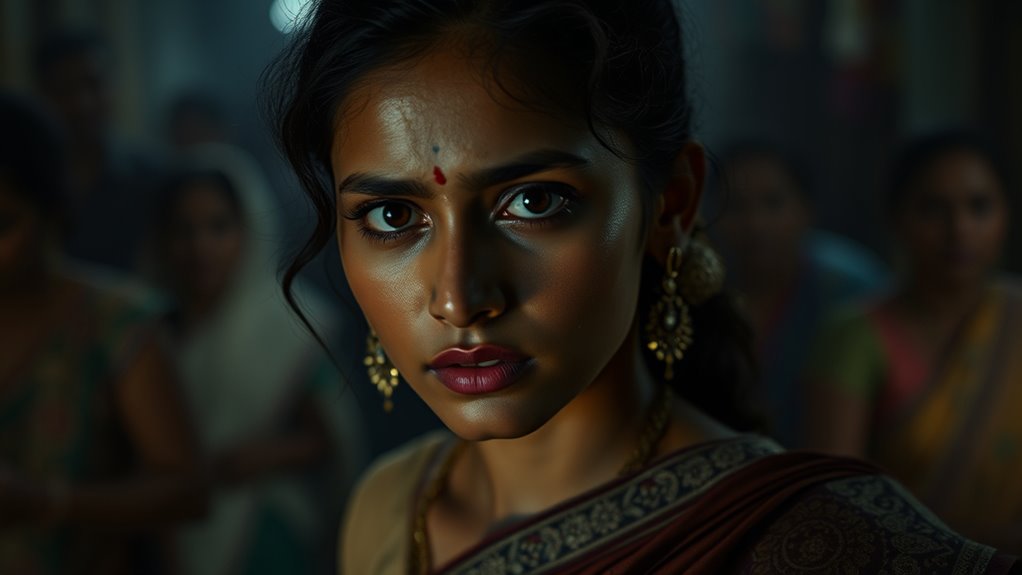
Alia Bhatt delivers a deeply nuanced performance in Gangubai Kathiawadi, transforming her portrayal into a compelling exploration of a woman’s journey from vulnerability to empowerment. You’ll notice how she immerses herself in the character through detailed research, capturing Gangubai’s emotional depth and resilience. Her physical transformation and close collaboration with Sanjay Leela Bhansali help her convincingly embody a young woman steering through societal oppression. Additionally, her ability to balance vulnerability and strength demonstrates her understanding of character complexity, making her portrayal both authentic and inspiring. Her dedication to understanding the character’s background adds authenticity. The film’s themes of empowerment and social justice come alive through her expressive acting. Audience and critics alike praise her for making the character’s evolution both believable and inspiring. Embracing emotional vulnerability allows her to connect more deeply with the audience, enhancing the authenticity of her portrayal. Recognizing the importance of actor preparation in delivering such performances, Alia’s commitment to her craft shines through. Her performance truly marks a career milestone, elevating her as one of Bollywood’s finest actresses.
Sushant Singh Rajput’s Nuanced Role in Sonchiriya

| Aspect | Details |
|---|---|
| Character Arc | From rebellious gang member to morally conflicted seeker |
| Performance Praise | Noted for nuance, depth, and emotional authenticity |
| Cultural Context | Authentic dialect and regional themes enrich the role |
| Impact | Strengthens the film’s social commentary and realism |
The Emotional Range of Rajesh Khanna in Anand
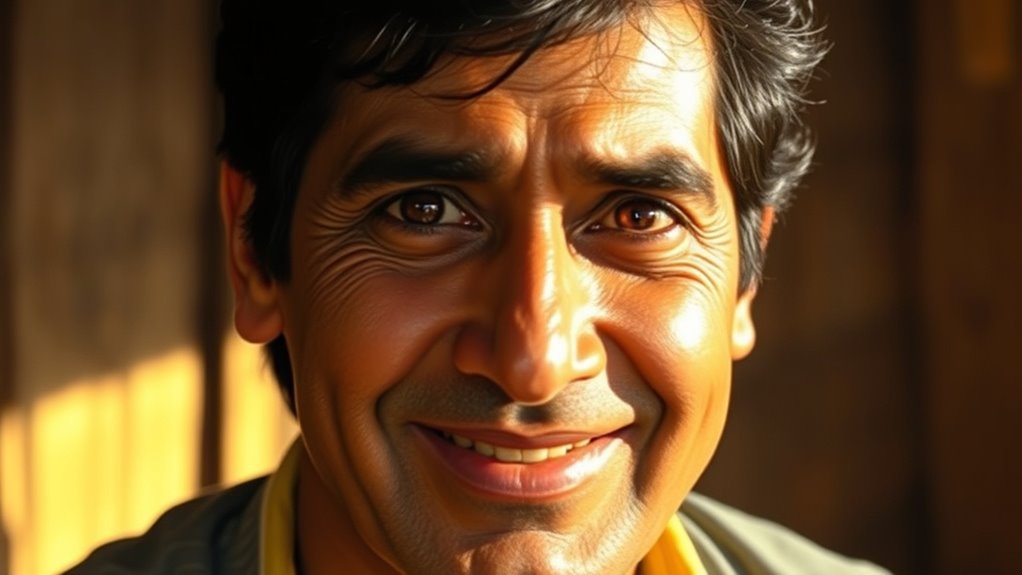
You can’t help but notice how Rajesh Khanna masterfully conveys a wide range of deep emotions in Anand, balancing joy and sorrow with authenticity. His dialogue delivery feels natural and heartfelt, drawing you into every moment. Through layered expressions, he captures Anand’s complex inner world, making his performance truly unforgettable.
Conveying Deep Emotions
Rajesh Khanna masterfully conveys a wide emotional spectrum in Anand, allowing viewers to feel the depth of his character’s inner world. His performance captures joy, suffering, acceptance, and hope with remarkable authenticity.
Here’s how he does it:
- Portrays joy and optimism through twinkling eyes and infectious laughter, masking his illness while inspiring others.
- Expresses vulnerability subtly during moments of solitude, revealing his true emotional state without melodrama.
- Balances pain and acceptance with gentle gestures and thoughtful pauses, showing inner strength and dignity.
- Connects emotionally with others and the audience, turning personal struggles into shared hope and resilience. Khanna’s nuanced portrayal makes every emotion felt deeply, elevating the film’s impact.
Mastery of Dialogue Delivery
The mastery of dialogue delivery in Anand showcases Rajesh Khanna’s exceptional ability to convey a wide emotional range, making each line resonate deeply with the audience. His distinct voice modulation and nuanced facial expressions bring life to iconic dialogues like “Babumoshai, zindagi badi honi chahiye, lambi nahin,” leaving a lasting impact. Khanna’s spontaneous pauses and natural body language create intimacy and authenticity, making every scene believable. His eye contact with co-actors enhances emotional depth, drawing viewers into Anand’s inner world. These delivery techniques helped turn memorable lines into life lessons and contributed profoundly to the film’s success. Khanna’s ability to balance humor and pathos through dialogue elevated his performance, cementing his legacy as a master of emotional expression in Indian cinema.
Multi-layered Emotional Expressions
Rajesh Khanna masterfully conveys a wide spectrum of emotions in “Anand,” demonstrating his ability to blend cheerfulness with profound vulnerability. You observe how his portrayal captures Anand Sehgal’s emotional complexity, from infectious smiles to quiet moments of sadness. His subtle facial expressions reveal vulnerability without dramatization, making his pain relatable. The character balances hope and despair, inspiring viewers with resilience. Consider these aspects:
- His smile masks underlying sadness, showing emotional control.
- Moments of numbness and resignation deepen his realism.
- Tears and damp cheeks highlight genuine vulnerability.
- Subtle emotional shifts create a believable, nuanced arc.
This layered emotional expression draws you into Anand’s inner world, making his journey both touching and unforgettable.
Critical Acclaim for Lesser-Known Gems and Performances
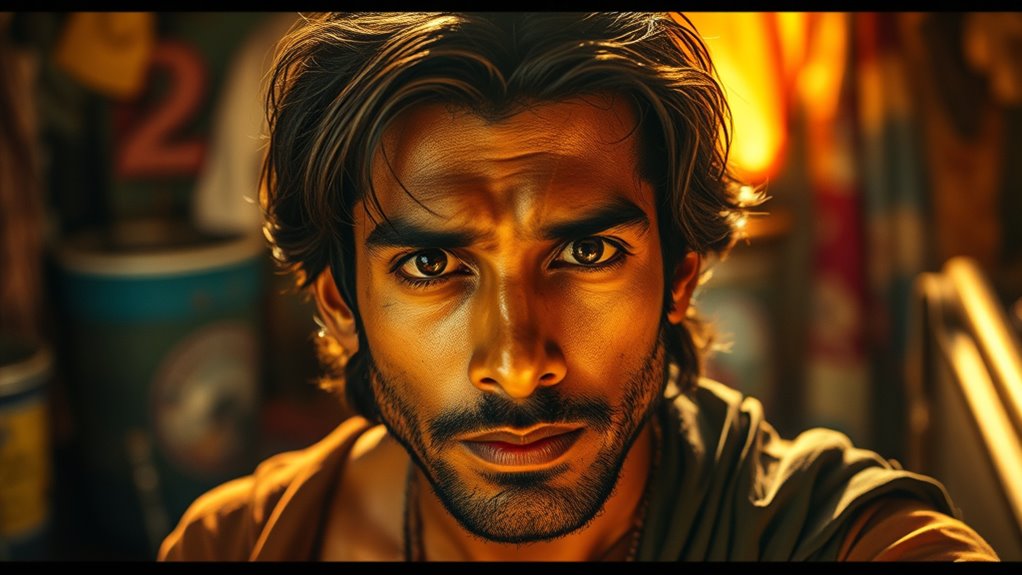
| Film | Notable Aspect |
|---|---|
| Iqbal | Inspiring tale of determination |
| Masaan | Cannes-winning emotional depth |
| Ship of Theseus | Philosophical storytelling |
| Lunchbox | Subtle human connection |
| Aamir | Challenging stereotypes |
Frequently Asked Questions
Which Bollywood Actors Are Considered the Most Versatile Across Genres?
You probably wonder which Bollywood actors stand out for their versatility across genres. Amitabh Bachchan, Kamal Haasan, and Aamir Khan top the list, as they excel in drama, comedy, action, and romance, constantly reinventing themselves. Similarly, Hrithik Roshan and Ranbir Kapoor showcase impressive range, handling complex characters in various genres. Their ability to adapt, take risks, and shine in different roles makes them some of the most versatile talents in Indian cinema today.
How Have Acting Techniques Evolved in Bollywood Over Decades?
You see, acting techniques in Bollywood have gracefully evolved over decades, blending tradition with innovation. Early on, actors embraced influences from Western theater, gradually developing deep character work and experimenting with roles. As cinema moved through its golden age and parallel movements, performers adopted more naturalistic styles. Today, technology and global exposure inspire actors to refine their craft, making performances more authentic, versatile, and appealing to diverse audiences worldwide.
What Role Does Awards Recognition Play in an Actor’S Legacy?
Awards recognition plays a vital role in shaping your legacy, as it documents your artistic achievements and reinforces your status in the industry. When you collect prestigious honors like National or Filmfare Awards, you cement your reputation and influence future generations. These accolades boost your credibility, open new opportunities, and help you become a symbol of excellence. Ultimately, awards serve as a lasting testament to your contribution to Indian cinema’s cultural heritage.
Are There Common Traits Among Critically Acclaimed but Lesser-Known Performances?
Did you know that many critically acclaimed yet lesser-known performances share common traits? You’ll find emotional depth, allowing actors to explore nuanced characters beyond typical roles. These performances often feature actors transforming or showcasing remarkable versatility. They resonate with current social issues or cultural themes, elevating the film. Your appreciation deepens when you notice how these actors bring authenticity and craft to their roles, leaving a lasting impact even if they’re not widely recognized.
How Do Cultural Influences Shape Iconic Bollywood Acting Performances?
You see, cultural influences deeply shape Bollywood acting performances by blending traditional theatrical styles like Parsi and Sanskrit theatre with modern storytelling. This fusion results in expressive, larger-than-life portrayals that reflect India’s societal values, festivals, and spiritual themes. You notice costumes, music, and dance amplify emotions, while visual techniques heighten drama. These cultural roots give performances a unique, vibrant energy that resonates locally and globally, making them truly iconic.
Conclusion
As you reflect on these unforgettable performances, one thing becomes clear—there’s always more beneath the surface. Each actor’s masterful portrayal leaves you craving for the next big surprise, the next hidden gem. The world of Bollywood is full of undiscovered depths, waiting to captivate you anew. So, keep watching, because someday, a performance will come along that will change everything you thought you knew about acting—and you won’t see it coming.



